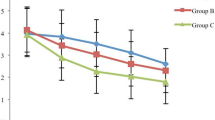Abstract
Background
Muscarinic receptors are involved in the mechanism of postoperative catheter-related bladder discomfort (CRBD). Glycopyrrolate and atropine as adjuncts to reversal of neuromuscular blockers have differential inhibitory effects on muscarinic receptors. This study was conducted to compare the effect of glycopyrrolate versus atropine on postoperative CRBD in patients undergoing transurethral resection of a bladder tumor (TURBT).
Methods
Seventy-four patients undergoing TURBT were randomly allocated to receive either glycopyrrolate 10 μg/kg (glycopyrrolate group, n = 37) or atropine 15 μg/kg (atropine group, n = 37) in combination with neostigmine 25 μg/kg at the end of surgery for reversal of neuromuscular blockade. The incidence and severity (mild/moderate/severe) of CRBD were assessed at 0, 1, 6, and 24 h postoperatively. Tramadol 50–100 mg was administered intravenously if the patients complained of moderate or severe CRBD.
Results
The incidence of CRBD was significantly lower in the glycopyrrolate group than in the atropine group at 0 h (65 % vs. 89 %, p = 0.025) and 1 h (54 % vs. 89 %, p = 0.002) postoperatively. The severity of postoperative CRBD was less severe in the glycopyrrolate group than in the atropine group at 0 h (p = 0.013) and 1 h (p = 0.006). Fewer patients required tramadol in the glycopyrrolate group than in the atropine group (3 % vs. 12 %, p = 0.024).
Conclusions
Glycopyrrolate as an adjunct to reversal of neuromuscular blockers decreased the incidence of early postoperative CRBD and postoperative tramadol requirements in patients undergoing TURBT when compared to atropine.
Similar content being viewed by others
References
Agarwal A, Raza M, Singhal V, Dhiraaj S, Kapoor R, Srivastava A, Gupta D, Singh PK, Pandey CK, Singh U. The efficacy of tolterodine for prevention of catheter-related bladder discomfort: a prospective, randomized, placebo-controlled, double-blind study. Anesth Analg. 2005;101:1065–7.
Tauzin-Fin P, Sesay M, Svartz L, Krol-Houdek MC, Maurette P. Sublingual oxybutynin reduces postoperative pain related to indwelling bladder catheter after radical retropubic prostatectomy. Br J Anaesth. 2007;99:572–5.
Guenther U, Radtke FM. Delirium in the postanaesthesia period. Curr Opin Anaesthesiol. 2011;24:670–5.
Lepouse C, Lautner CA, Liu L, Gomis P, Leon A. Emergence delirium in adults in the post-anaesthesia care unit. Br J Anaesth. 2006;96:747–53.
Anderson KE. Pharmacology of lower urinary tract smooth muscles and penile erectile tissues. Pharmacol Rev. 1993;45:253–308.
Agarwal A, Gupta D, Kumar M, Dhiraaj S, Tandon M, Singh PK. Ketamine for treatment of catheter related bladder discomfort: a prospective, randomized, placebo controlled and double blind study. Br J Anaesth. 2006;96:587–9.
Agarwal A, Yadav G, Gupta D, Singh PK, Singh U. Evaluation of intra-operative tramadol for prevention of catheter-related bladder discomfort: a prospective, randomized, double-blind study. Br J Anaesth. 2008;101:506–10.
Ryu JH, Hwang JW, Lee JW, Seo JH, Park HP, Oh AY, Jeon YT, Do SH. Efficacy of butylscopolamine for the treatment of catheter-related bladder discomfort: a prospective, randomized, placebo-controlled, double-blind study. Br J Anaesth. 2013;111:932–7.
Kim HC, Lee YH, Jeon YT, Hwang JW, Lim YJ, Park JE, Park HP. The effect of intraoperative dexmedetomidine on postoperative catheter-related bladder discomfort in patients undergoing transurethral bladder tumour resection: A prospective, double-blind, randomised study. Eur J Anaesthesiol. 2014;. doi:10.1097/EJA.0000000000000196.
Haddad EB, Patel H, Keeling JE, Yacoub MH, Barnes PJ, Belvisi MG. Pharmacological characterization of the muscarinic receptor antagonist, glycopyrrolate, in human and guinea-pig airways. Br J Pharmacol. 1999;127:413–20.
Nelson CP, Gupta P, Napier CM, Nahorski SR, Challiss RA. Functional selectivity of muscarinic receptor antagonists for inhibition of M3-mediated phosphoinositide responses in guinea pig urinary bladder and submandibular salivary gland. J Pharmacol Exp Ther. 2004;310:1255–65.
Mirakhur RK, Dundee JW, Jones CJ, Coppel DL, Clarke RS. Reversal of neuromuscular blockade: dose determination studies with atropine and glycopyrrolate given before or in a mixture with neostigmine. Anesth Analg. 1981;60:557–62.
Kim HC, Kim E, Jeon YT, Hwang JW, Lim YJ, Seo JH, Park HP. Postanaesthetic emergence agitation in adult patients after general anaesthesia for urological surgery. J Int Med Res. 2015;43:226–35.
Appell RA. Clinical efficacy and safety of tolterodine in the treatment of overactive bladder: a pooled analysis. Urology. 1997;50:90–6.
Eglen RM. Muscarinic receptor subtypes in neuronal and non-neuronal cholinergic function. Auton Autacoid Pharmacol. 2006;26:219–33.
Agarwal A, Dhiraaj S, Pawar S, Kapoor R, Gupta D, Singh PK. An evaluation of the efficacy of gabapentin for prevention of catheter-related bladder discomfort: a prospective, randomized, placebo-controlled, double-blind study. Anesth Analg. 2007;105:1454–7.
Agarwal A, Dhiraaj S, Singhal V, Kapoor R, Tandon M. Comparison of efficacy of oxybutynin and tolterodine for prevention of catheter related bladder discomfort: a prospective, randomized, placebo-controlled, double-blind study. Br J Anaesth. 2006;96:377–80.
Binhas M, Motamed C, Hawajri N, Yiou R, Marty J. Predictors of catheter-related bladder discomfort in the post-anaesthesia care unit. Ann Fr Anesth Reanim. 2011;30:122–5.
Conflict of interest
None.
Author information
Authors and Affiliations
Corresponding author
Additional information
Trial Registration Identifier: NCT02228473 (www.clinicaltrials.gov).
About this article
Cite this article
Kim, HC., Lim, SM., Seo, H. et al. Effect of glycopyrrolate versus atropine coadministered with neostigmine for reversal of rocuronium on postoperative catheter-related bladder discomfort in patients undergoing transurethral resection of bladder tumor: a prospective randomized study. J Anesth 29, 831–835 (2015). https://doi.org/10.1007/s00540-015-2064-2
Received:
Accepted:
Published:
Issue Date:
DOI: https://doi.org/10.1007/s00540-015-2064-2




